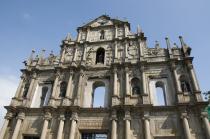Macau
Although Portuguese carracks had successfully plied the maritime routes between Lisbon and the Spice Islands for some decades in the early part of the sixteenth century, they realized that it was prudent to have access to ports where they could replenish their supplies, repair their boats and sails if necessary and take shelter from storms and hardship. To this end they established fortified stations in ports that offered these advantages and which were located at strategic parts of the sea-lanes.
They first went to Macau in the 1530s. Macau was conveniently located at the mouth of the Pearl River Delta and as it was an isthmus jutting out from one side of the landmass of southern China it also possessed good defensive attributes. The local Chinese authorities did not initially allow them to settle there but by the middle of the 1550s a town of sorts had been established. The Chinese built a fortified wall to cut off the isthmus from the rest of the landmass and this provided de facto control to the Portuguese.
The port was a welcome safe haven for the Portuguese fleets from the seasonal monsoons and typhoons and was also an important link in the chain of Portuguese maritime control. Most important, however, was its connection to nearby Japan and the port of Nagasaki (through which almost all of the Japanese silk trade passed at this time) and to the seasonal trade fairs held in Guangzhou, further along the Pearl River Delta. The strategic significance of Macau was proven by the attempts of the Dutch East India Company to take it by force but they were repulsed and had to settle with using their base at Batavia.
The Society of Jesus established their presence in Macau in 1563 and over the following decades developed a college, and a seminary. Just as Macau was a stepping-stone for the Portuguese traders so too did it become the door through which the missionaries passed into China. Through this door too flowed the knowledge that these missionaries brought to China and which they took back - or sent in the form of letters and journals – to Europe.



